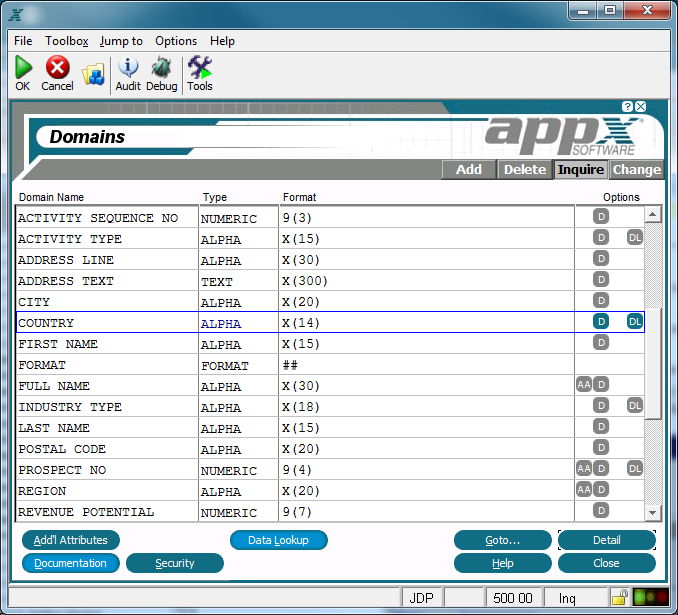Chapter 1-1: Overview of Application Design |
Domains Screen The Domains screen contains general attributes that are common to all domains. The Type you enter on this screen for a domain governs the subsequent screens that APPX displays to further define the domain. Domain specifications establish values for all fields that reference the domain and cannot be overridden. Therefore, it may be desirable to leave some attributes blank (such as descriptive name or column headings) to allow for making individual entries at the field level. You access the Domains screen, shown below, by selecting Domains from the Application Design Menu.
Domains Screen The Domains screen contains the following fields: Domain Name uniquely identifies the domain within an APPX application. Fields assume the attributes of a domain by referencing the domain?s Domain Name. (22 uppercase alphanumeric characters, restricted to numbers, letters, and spaces). The name may represent a specific field that references the domain, such as an Account Number domain, or a category of fields, such as an Amount domain that is referenced by a number of different fields, including AP Invoice Amount, Sales, AR Invoice Amount, Total Purchases, and Order Amount. Type categorizes the domain according to its specific content or function in APPX. The specifications presented on subsequent screen overlays depend on the Type entered here, although most types share some common specifications.The domain Type options are: Alpha domains are patterns for fields comprised of letters, numbers, and special characters (-, #, or &, for example), where the primary characteristic is field length. Format domains are like alpha domains except that an edit mask is the primary characteristic. System domains are patterns for fields that contain data provided by the system, often referred to as audit fields. Text domains are patterns for fields comprised of blocks of text. Token domains are like alpha domains except they have specific values that are stored as corresponding numbers. Numeric domains are patterns for fields restricted to number, decimal (.), and sign (-) entries. Date domains are patterns for fields that contain dates and/or times, from a hundredth of a second through a century.
Logic domains are patterns for fields with possible values of yes Same As domains are patterns for fields that share the same characteristics as a domain in another application in your database. If you enter a partial value, APPX selects the option with the next highest value. For example, an entry of ALPHA or A is equivalent to entering ALPHA. An entry of C references the next highest value: DATE. Each option is discussed in detail in the corresponding section. Format displays a symbolic representation of the domain for ease of reference. It is generated by APPX according to the detail specifications entered for the domain and cannot be edited. Options are indicators that display whenever documentation (T), data lookup (DL), or additional attributes (AA) have been defined for this domain. Three options are available from the Domains screen as described in the corresponding sections: |
Application Design Manual "Powered by Appx Software"147 ©2006 By APPX Software, Inc. All Rights Reserved |
